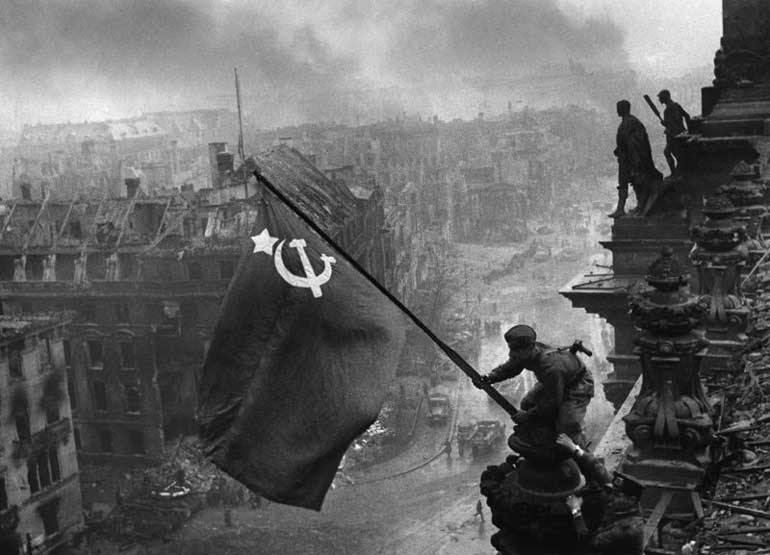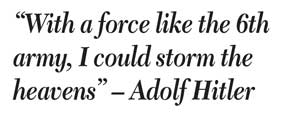Sunday Apr 06, 2025
Sunday Apr 06, 2025
Thursday, 5 November 2015 00:00 - - {{hitsCtrl.values.hits}}


Between August of 1942 and January of 1943 an epic battle was waged in the Soviet city of Stalingrad , which in the opinion of many commentators determined the course of the Second World War and thereby the path of history. Had the Germans taken the city early, many things now we take for granted may have evolved very differently.
Having swept across the endless Russian plains with relative ease, the German armies did not anticipate great difficulties in taking the city. Stalingrad was not initially a strategic imperative, in the German plans it was only to be an interim stop on their way to destroying the Soviet State. On the other hand, for the beleaguered Russian troops, having retreated all summer under terrible conditions, to forego the city that bore the name of Stalin was no option. Less hopefully, but with a quiet determination, they had decided that they would retreat no more.
The soldiers of the Red army fighting to defend the city on the Volga will either hold their ground or perish in the process. As things turned out, there was a lot more staked on the ensuing battle for Stalingrad than the mere fate of a large city.
1941
As the surprise Soviet counter-offensive of the winter of 1941 petered out in the freezing snows of the Russian wilderness, the minds of the German war planners began to turn to the inevitable summer campaign ahead, their successive offensive against a bloodied but defiant enemy.
Six months before, on 22 June 1941, the awesome and seemingly unstoppable German war machine had launched itself at Russia, the largest country in the world, with a sudden and devastating ferocity. For this unprecedented attack the Germans had divided their four million strong striking force into three large army groups. Army Group North was to dash up to Leningrad, while bringing the Baltic area under its heel. The task of the exceptionally strong Army Group Centre was to thrust in to the Russia heartland with Moscow as the desired long stop. The Donets River was the ambitious summer target for the Army Group South with the Ukraine and Crimea as the rich prizes.
Only from an army in the class of the Wehrmacht could a task of such scale and ambition be demanded. No army in history had to conquer a land as vast and an enemy as formidable in just one furious campaign. To even contemplate such an undertaking the attacker had to possess outstanding soldiery as well as a capacity for extraordinary efficiency. Germany was obviously blessed with both.
The war opened dazzlingly for the Teutonic warriors. Punching huge gaps in the bewildered enemy defence lines the formidable Panzer divisions of the Germans streaked across the Russian plains leaving the mopping up to the slower infantry divisions. These highly trained men of the infantry, while continuously fighting the retreating Russians marched a regular 30 miles a day, determined to keep cohesion with their comrades in the fast moving armoured units relentlessly moving east.
But the country, that Germany had now locked horns with was immense, the enemy exceedingly tough. It is testimony to the superlative calibre of German arms that they, hopelessly over-stretched after six months of continuous fighting, almost achieved victory. In the north they surrounded Leningrad and imposed a crippling siege on the city. In the centre, German reconnaissance units stomped through knee high snow to the out skirts of Moscow. In the south most of Ukraine was theirs.
The Russian bear was dreadfully mauled, but was refusing to lie down.
In the huge gamble the Germans had taken, even a near victory amounted to a strategic defeat. Although the Germans were now deep in Russia, given the size of the country and the endless supply of men and material Russia could command, it was still in a position to continue resisting strongly. The fundamental failure of the Wehrmacht to achieve a decisive win in 1941 now necessitated a renewed offensive in 1942 to bring the enemy to heel, once and for all.
But after the dreadful winter battles of 1941, when Russians launched quite an effective counter punch, Germans were not in a position to renew their attack on all three fronts. After much consideration they picked on the economically vital Southern Front, with the hope that their superior military could administer such a crippling blow to the Russians that they would be compelled to surrender. The Army Groups North and Centre were to remain on a defensive posture with a few local offensives to keep the Russian defenders in those fronts pinned down.
1942
For the gigantic attack of 1942 the Army Group South was reorganised with Field Marshall Von Bock in overall charge. Under his command were several armies including the 2nd army, 17th army, the 6th army, the 1st Panzer army and the 4th Panzer army. Any one of these armies was capable of delivering a crippling blow to the enemy while the 6th was particularly strong with 11 divisions and an entire Panzer Corps in its establishment.
Operation Blue, as the plan was named, was somewhat vague on its final objectives, but envisaged reaching the Volga in the East, bringing the large city of Stalingrad under control while reaching the Eastern Caucasus during the campaign. Again it was hoped that by menacing this vital area they could compel the Soviets to commit its precious reserves thus presenting the Germans with an opportunity to force the issue.
The Germans had no doubts about the superiority of their fighting men. Repeatedly, they had observed the clumsy battle tactics and the wooden orthodoxy of the Russian commanders. In contrast the Germans were trained and encouraged to fight unconventionally and resourcefully. Rather than attempting to overwhelm the enemy with mere numbers and often wasteful firepower, the Wehrmacht embraced the idea of paralysing their foe with speed and effectiveness.
On 28th of June 1942 Von Bock opened his offensive with predictable ferocity, within days splitting the Russian front in to rapidly disintegrating fragments. Once again the vaunted armoured divisions of the Germans advanced East across the massive steppe seeking an opportunity to mortally wound the enemy. Not only were they assured of their military supremacy, the Germans were also convinced of their racial superiority over an enemy whom their internal military magazines routinely described in terms such as-“ degenerate looking Orientals, begging whining Asians, a mixture of low and the lowest humanity, truly subhuman”.
By 22 August elements of the German 6th Army, now under the command of General Friedrich Paulus, had reached the Volga, in the borders of the Asian continent, a remarkable advance since June 1941. Stalingrad, the city carrying the name of the Soviet dictator was tantalisingly within grasp.
The next day, 23 August, with predictable efficiency the German Air Force began carpet-bombing the ill-fated city. The resulting fires turned Stalingrad in to a burning inferno of collapsed buildings, rubble and thick smoke. No human force could resist the German firepower in those conditions. Hitler who had baulked at the idea of committing his troops to city fighting in Moscow and Leningrad the previous year, now decided that he must have Stalingrad. Perhaps less sanguinely, but certainly with grim determination, Stalin had also decided that Russia would not retreat any further.
So began the titanic struggle between these two implacable enemies for a burnt out patch of the earth, which finally became the turning point of the Second World War. For the valiant Russian defenders there was little choice. They faced the fury of the German guns well aware that retreat only meant drowning in the freezing waters of the Volga. Besides, Joseph Stalin who knew how to impose his will had placed Secret Service Police detachments in the rear with strict orders to summarily execute any Russian soldier disobeying the order to hold his ground.
For the Germans, the battle for Stalingrad turned their world upside down. Their armoured divisions trained to capture something like 50 miles a day, were now advancing at snail pace, and attempting to subdue a burning city against an enemy who rarely showed himself. One single building would change hands several times in a day, each battle only adding to the corpses lying on the floor. In such close quarter fighting German planes and tanks were unable to join effectively through the fear of hitting their own.
A German Lieutenant with the 24th Panzer division described the battlefield thus “Stalingrad is no longer a city. By day it is an enormous cloud of burning, blinding smoke; it is a vast furnace lit by the reflection of the flames. And when the nights arrive, one of those scorching, howling, bleeding nights, the dogs plunge in to the Volga and swim desperately to gain the other bank. The nights of Stalingrad are a terror for them. Animals flee this hell; the hardest stones cannot bear it for any longer; only men endure.”
While the climacteric battle was raging in this man made hell-hole of a burning city hundreds of powerful German divisions were holding their impossibly long front line from the Baltic Sea to the Caucasus Mountains, many almost on an R&R mode. General Paulus himself could only commit eight of the divisions of the 6th Army to the crucial battle in the city while assigning eleven divisions under his command to guard the large area under the Army’s administration and his almost 200 mile long exposed flanks.
As the battle dragged on in to the Russian winter many a General warned of the dangers inherent in a prestige battle, where the German army was paying a price totally out of proportion to the city’s fast diminishing strategic importance. But the Majority of the high command including Hitler, who held the Russians in contempt, could not conceive of a large-scale counteroffensive by them. The Wehrmacht, which had traditionally prided itself on its cold rationality, was now acting increasingly on hateful prejudices, arrogance and unwarranted optimism. So General Paulus, the harried commander of the 6th Army who was considered a competent staff office, if slow-witted and unimaginative in the field, continued with tactics designed to grind down the enemy inch by inch, an approach which was essentially counter-productive to the numerically weaker but technically superior Germans.
The German battle order in the Stalingrad area now presented Marshall Zhukov the Russian commander, legendary for his coolness under pressure, with a situation where he could turn tables on the enemy. The German 6th Army intent on gaining Stalingrad at any cost was fully absorbed in city fighting. Its long and difficult flanks guarded mainly by satellite divisions from Rumania and Hungary with a sprinkling of German units, were vulnerable. These satellite armies were far inferior to the Germans in equipment as well as in fighting qualities. The nearest German formations of any size were far away in the Caucasus absorbed in heavy fighting in that mountain region.
Realising the latent opportunity in the situation, Zhukov decided to keep the battle of Stalingrad going even at a heavy price while secretly accumulating huge forces at the extremities of the German flanks. It was a hard decision. The men he ferried across the Volga to battle the Germans in the inferno of Stalingrad had extremely low chances of returning alive. But in order to keep the Germans firmly focused on the city, Zhukov was willing to pay with blood for time. For almost four months the two armies waged a ferocious battle for the few remaining square miles of the city of Stalingrad.
Then in the early hours of 19 November 1942, when the freezing winter of Russia was well advanced, Zhukov struck. The Russians, in two huge pincer attacks, pierced the flanks of the 6th Army and moved rapidly towards the town of kalach their intended meeting point. On their advance the Russians met only feeble resistance from the Rumanians and the Hungarians, the satellite troops, to whom the Germans had entrusted the task of guarding the rear of the 6th Army.
When the two pincer arms of the Russians met at Kalach on 22 November, they had entrapped the great 6th Army of the Germans. In the bleak icy Russian Steppe, covered by a numbing winter mist, the turning point of the Second World War had been reached. Although the Germans were to fight on doggedly for another two and half years, they had lost the initiative. From then on they were largely an Army in defence.